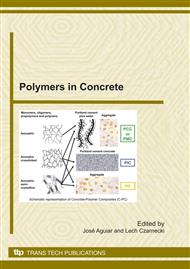p.73
p.85
p.97
p.105
p.115
p.121
p.131
p.141
p.151
Mechanical Behaviour and Thermal Conductivity of Mortars with Waste Plastic Particles
Abstract:
In the present paper an investigation of mechanical behaviour and thermal conductivity of a lightweight building material containing either styrene butadiene rubber (SBR) or polyurethane (PU) waste particles is presented. Several mortar mixtures were prepared by replacing quartz sand with 0, 10 and 30% of either SBR or PU post-consumer plastics particles. The influence of rubber particle addition on fresh mortar behaviour, compressive and flexural strength of mortar as well as on mortar thermal conductivity was investigated. An optimization of mortar mixture proportions was carried out by adding a limestone powder as filler. The experimental investigation showed that the addition of rubber particles reduces both the material unit weight and the thermal conductivity. The thermal insulating effect of rubber particles indicates a promising potential for future developments. On the other hand, the addition of limestone powder produced higher thermal conductivity as well as higher compressive and flexural strength.
Info:
Periodical:
Pages:
115-120
Citation:
Online since:
January 2011
Authors:
Keywords:
Price:
Сopyright:
© 2011 Trans Tech Publications Ltd. All Rights Reserved
Share:
Citation:


